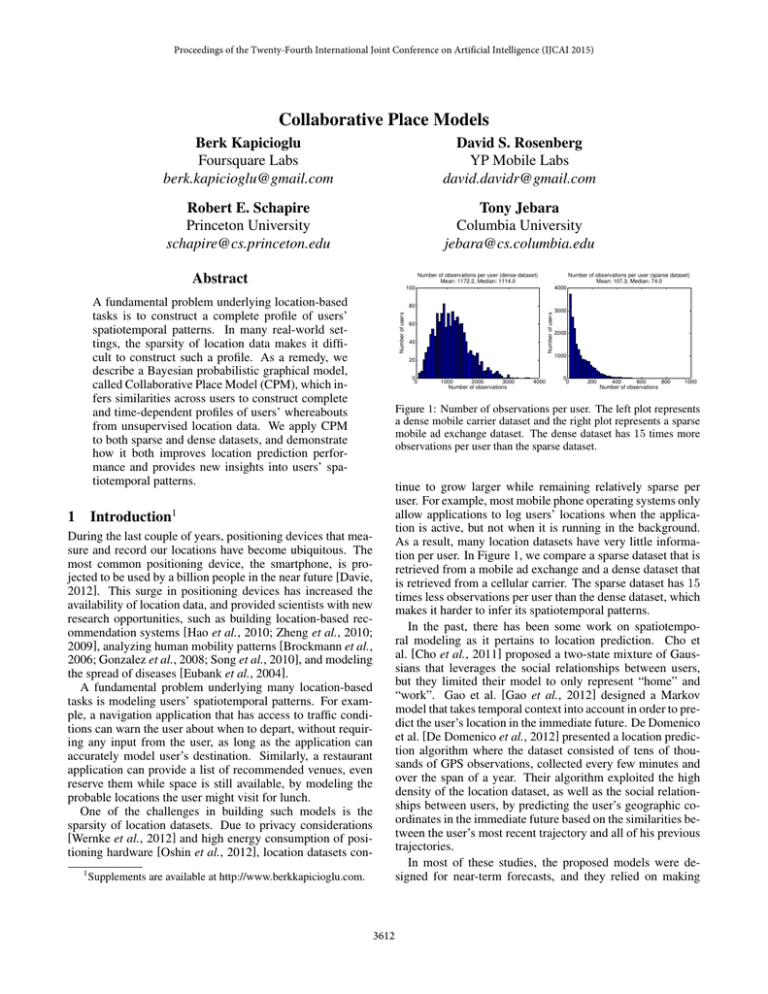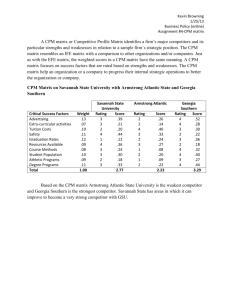Collaborative Place Models
advertisement

Proceedings of the Twenty-Fourth International Joint Conference on Artificial Intelligence (IJCAI 2015)
Collaborative Place Models
Berk Kapicioglu
Foursquare Labs
berk.kapicioglu@gmail.com
David S. Rosenberg
YP Mobile Labs
david.davidr@gmail.com
Robert E. Schapire
Princeton University
schapire@cs.princeton.edu
Tony Jebara
Columbia University
jebara@cs.columbia.edu
Abstract
Number of observations per user (dense dataset)
Mean: 1172.2, Median: 1114.0
A fundamental problem underlying location-based
tasks is to construct a complete profile of users’
spatiotemporal patterns. In many real-world settings, the sparsity of location data makes it difficult to construct such a profile. As a remedy, we
describe a Bayesian probabilistic graphical model,
called Collaborative Place Model (CPM), which infers similarities across users to construct complete
and time-dependent profiles of users’ whereabouts
from unsupervised location data. We apply CPM
to both sparse and dense datasets, and demonstrate
how it both improves location prediction performance and provides new insights into users’ spatiotemporal patterns.
Number of users
Number of users
60
40
0
0
3000
2000
1000
20
1000
2000
3000
Number of observations
4000
0
0
200
400
600
800
Number of observations
1000
Figure 1: Number of observations per user. The left plot represents
a dense mobile carrier dataset and the right plot represents a sparse
mobile ad exchange dataset. The dense dataset has 15 times more
observations per user than the sparse dataset.
tinue to grow larger while remaining relatively sparse per
user. For example, most mobile phone operating systems only
allow applications to log users’ locations when the application is active, but not when it is running in the background.
As a result, many location datasets have very little information per user. In Figure 1, we compare a sparse dataset that is
retrieved from a mobile ad exchange and a dense dataset that
is retrieved from a cellular carrier. The sparse dataset has 15
times less observations per user than the dense dataset, which
makes it harder to infer its spatiotemporal patterns.
In the past, there has been some work on spatiotemporal modeling as it pertains to location prediction. Cho et
al. [Cho et al., 2011] proposed a two-state mixture of Gaussians that leverages the social relationships between users,
but they limited their model to only represent “home” and
“work”. Gao et al. [Gao et al., 2012] designed a Markov
model that takes temporal context into account in order to predict the user’s location in the immediate future. De Domenico
et al. [De Domenico et al., 2012] presented a location prediction algorithm where the dataset consisted of tens of thousands of GPS observations, collected every few minutes and
over the span of a year. Their algorithm exploited the high
density of the location dataset, as well as the social relationships between users, by predicting the user’s geographic coordinates in the immediate future based on the similarities between the user’s most recent trajectory and all of his previous
trajectories.
In most of these studies, the proposed models were designed for near-term forecasts, and they relied on making
During the last couple of years, positioning devices that measure and record our locations have become ubiquitous. The
most common positioning device, the smartphone, is projected to be used by a billion people in the near future [Davie,
2012]. This surge in positioning devices has increased the
availability of location data, and provided scientists with new
research opportunities, such as building location-based recommendation systems [Hao et al., 2010; Zheng et al., 2010;
2009], analyzing human mobility patterns [Brockmann et al.,
2006; Gonzalez et al., 2008; Song et al., 2010], and modeling
the spread of diseases [Eubank et al., 2004].
A fundamental problem underlying many location-based
tasks is modeling users’ spatiotemporal patterns. For example, a navigation application that has access to traffic conditions can warn the user about when to depart, without requiring any input from the user, as long as the application can
accurately model user’s destination. Similarly, a restaurant
application can provide a list of recommended venues, even
reserve them while space is still available, by modeling the
probable locations the user might visit for lunch.
One of the challenges in building such models is the
sparsity of location datasets. Due to privacy considerations
[Wernke et al., 2012] and high energy consumption of positioning hardware [Oshin et al., 2012], location datasets con1
4000
80
Introduction1
1
Number of observations per user (sparse dataset)
Mean: 107.3, Median: 74.0
100
Supplements are available at http://www.berkkapicioglu.com.
3612
predictions based on the most recent observations. However,
there are many real-world applications where the test example and the most recent training example are temporally apart,
and for all purposes, statistically independent. For such predictions, a model that relies on the most recent observations
would not suffice; instead, the model would need to make predictions based on the user’s global spatiotemporal patterns.
In addition to the work listed above, researchers have also
studied spatiotemporal modeling as it pertains to the detection
of significant places and routines. Eagle and Pentland [Eagle and Pentland, 2009] applied eigendecomposition to the
Reality Mining dataset, where all locations were already labeled as “home” or “work”, and extracted users’ daily routines. Farrahi and Gatica-Perez [Farrahi and Perez, 2011]
used the same dataset, but extracted the routines using Latent
Dirichlet Allocation (LDA) instead of eigendecomposition.
Liao et al. [Liao et al., 2005; 2007] proposed a hierarchical
conditional random field to identify activities and significant
places from the users’ GPS traces, and since their algorithm
was supervised, it required locations to be manually labeled
for training. In contrast to previous work, our model does
not require labeled data; instead, it relies only on user IDs,
latitudes, longitudes, and time stamps.
In this paper, we propose a new Bayesian probabilistic
graphical model, called Collaborative Place Model (CPM),
which recovers the latent spatiotemporal structure underlying unsupervised location data by analyzing patterns shared
across all users. CPM is a generalization of the Bayesian
Gaussian mixture model (GMM), and assumes that each user
is characterized by a varying number of place clusters, whose
spatial characteristics, such as their means and covariances,
are determined probabilistically from the data. However, unlike GMM, CPM also assigns users weakly similar temporal
patterns; ones which do not force different users to have the
same place distribution during the same weekhour.
The spatiotemporal patterns extracted by CPM are helpful
in leveraging both sparse and dense datasets. In case of sparse
data, the model infers a user’s place distribution at a particular weekhour, even if the user has not been observed during
that weekhour before. In case of dense data, sampling bias
usually yields fewer observations for certain hours (e.g. users
make more phone calls during day time than after midnight),
and the model successfully infers the user’s behavior during
these undersampled hours. In both cases, the model combines
the globally shared temporal patterns with user’s own spatiotemporal patterns and constructs a customized, complete,
and time-dependent profile of the user’s locations.
Aside from its quantitative benefits, CPM also provides
qualitative insights about the universal temporal patterns of
human populations. Even though the model is given no prior
information about the relationship between weekhours, it successfully extracts temporal clusters such as the hours spent
during morning commute, work, evening commute, leisure
time after work, and sleeping at night.
The paper proceeds as follows. In Section 2, we provide a
formal description of CPM. In Section 3, we derive the inference algorithms. In Section 4, we demonstrate our model on
two real location datasets. We conclude in Section 5.
Figure 2: Graphical models. An earlier prototype we built is represented on the left and CPM is represented on the right. The geographic coordinates, denoted by `, are the only observed variables.
2
Collaborative Place Model
In this section, we provide a formal description of CPM and
describe its generative process. CPM comprises a spatial part,
which represents the inferred place clusters, and a temporal
part, which represents the inferred place distributions for each
weekhour. The model is depicted on the right side of Figure
2.
The temporal part of CPM assumes that, for each user u
and weekhour w, the corresponding place distribution is a
convex combination of F factorized place distributions, each
of which is represented by θ fu . These factorized place distributions are dependent on the user, but they are independent
of the weekhour. In contrast, the coefficients of the convex
combination, represented by γ w , are shared across all users.
Using this factorization, CPM combines global temporal patterns with user-specific spatiotemporal patterns and infers
each user’s place distribution even for weekhours where the
user has not been observed before. Furthermore, by not restricting each user to have the same number of places or each
weekhour to have the same distribution over places, CPM allows a realistic and flexible representation of the users’ location profiles.
The flexible temporal representation provided by CPM
turns out to be essential for our problem. Early in the project,
we have built a simpler prototype, depicted on the left side
of Figure 2, which constrained all users to have the same
weekhour distribution. However, it performed even worse
than the baseline model with respect to the usual metrics (i.e.
held-out log-likelihood), so we abandoned it. In contrast to
this prototype, CPM allows us both to share temporal information across users and to provide a more flexible temporal
representation for each user.
Let u represent a user, ranging from 1 to U , and let f represent a factor index, ranging from 1 to F . For each user
u and factor index f , let θ fu ∈ RKu denote the Dirichlet
random variable that represents the corresponding factorized
place distribution, where Ku denotes the number of places
for each user u. Intuitively, θ fu ∈ RKu describes the building blocks of user’s place preferences. Furthermore, let w
denote a weekhour, ranging from 1 to W . The Dirichlet random variable γ w ∈ RF denotes the factor weights, which
when combined with the user’s factorized place distributions,
3613
(a) Draw a place covariance Σku ∼ IW (Λk , ν).
Σk
(b) Draw a place mean φku ∼ N µu , puu .
yields the user’s place distribution for weekhour w.
At a high level, the generative process proceeds as follows.
The variable γ w generates yu,w,n , the factor assignment for
user u and observation n at weekhour w, and the factor assignment generates the place assignment zu,w,n from the factorized place distribution θ yuu,w,n . The place assignment is in
turn used to sample the observed coordinates `u,w,n from the
corresponding place cluster.
The place clusters, whose means and covariances are
unique to each user, are modeled by the spatial part of CPM.
Intuitively, we expect each place cluster to correspond to locations such as “home”, “work”, and “gym”. Given a user u
and a place index k, each place cluster is characterized by a
bivariate normal distribution, with mean φku and covariance
Σku . The observed coordinates ` are considered to be noisy
observations sampled from these place clusters.
Our model uses conjugate priors because of the computational advantages they provide in Bayesian inference. For
the random variables θ fw and γ w , the prior is a symmetric Dirichlet with concentration parameter α > 0, where
DirichletK (α) denotes the K-dimensional distribution. For
the random variables associated with the place clusters, φku
and Σku , the prior is a normal-inverse-Wishart (NIW) distribution. Λ ∈ R2×2 is a positive definite scale matrix, ν>1
indicates the degrees of freedom, and together they define the
distribution over the covariance matrix. The parameter µu is
customized for each user u and is computed as the mean of
the user’s historical locations. The parameter puk is set such
that the prior covariance of the place mean (i.e. prior covariance of φku ) is very large.
In location datasets, a user sometimes logs locations that
are one-offs and are not representative of the user’s regular location profile. To ensure that such outliers do not affect how
the model infers the user’s regular place clusters, we designate the last place, place Ku , as a special outlier place and set
u
its covariance’s prior mean (i.e. prior mean of ΣK
u ), as determined by ΛKu , to be very large. As for the covariance of
regular clusters, we set the remaining scale matrices, Λ−Ku ,
such that each coordinate of the covariance’s prior mean has
a standard deviation of 150 meters. This is a reasonable size
for a place cluster, as it is large enough to encapsulate both
the potential inaccuracies of location hardware and the inherent noise in the users’ locations, but small enough to ensure
that each place cluster corresponds to a single intuitive place,
such as “home” or “work”.
Let N denote the normal distribution and IW denote the
inverse-Wishart distribution. Let DirichletK (·) denote a symmetric Dirichlet if its parameter is a scalar and a general
Dirichlet if its parameter is a vector. The generative process
of CPM is described in more formal terms below. Further
technical details about the distributions we use in our model
can be found in the supplement.
1. For each weekhour w, draw a distribution over factors
γ w ∼ DirichletF (β).
2. For each user u and factor f , draw a factorized place
distribution θ fu ∼ DirichletKu (α).
3. For each user u and place k,
k
4. For each user u, weekhour w, and observation index n,
(a) Draw a factor assignment
yu,w,n ∼ Categorical(γ w ).
(b) Draw a place assignment
zu,w,n ∼ Categorical(θ yuu,w,n ).
(c) Draw a location
`u,w,n ∼ N (φzuu,w,n , Σzuu,w,n ).
3
Inference
In this section, we derive our inference algorithm, and we
present our derivation in multiple steps. First, we derive a
collapsed Gibbs sampler to sample from the posterior distribution of the categorical random variables conditioned on the
observed geographic coordinates. Second, we derive the conditional likelihood of the posterior samples, which we use
to determine the sampler’s convergence. Third, we derive
formulas for approximating the posterior expectations of the
non-categorical random variables conditioned on the posterior samples. Finally, in the last step, we combine all the
previous derivations to construct a simple algorithm for efficient posterior inference. We state the main results below.
The proofs are provided in the supplement.
In Lemmas 1 and 2, we describe the collapsed Gibbs sampler for variables z and y, respectively. Given a vector x and
an index k, let x−k indicate all the entries of the vector excluding the one at index k. We assume that i = (u, w, n)
denotes the index of the variable that will be sampled. First,
we state the posterior probability of z.
Lemma 1. The unnormalized probability of zi conditioned
on the observed location data and remaining categorical
variables is
p zi = k | yi = f, z −i , y −i , `
!
k
Λ̃u (p̃uk + 1)
u
∝ tṽku −1 `i | µ̃k , u u
α + m̃k,f
u,· .
p̃k (ṽk − 1)
k
The parameters ṽku , µ̃uk , Λ̃u , and p̃uk are defined in the proof. t
denotes the bivariate t-distribution and m̃k,f
u,· denotes counts,
both of which are defined in the supplement.
Next, we state the posterior probability of y.
Lemma 2. The unnormalized probability of yi conditioned
on the observed location data and remaining categorical
variables is
p yi = f | zi = k, y −i , z −i , `
∝
α + m̃k,f
u,·
Ku α +
m̃·,f
u,·
βw,f + m̃·,f
·,w ,
·,f
·,f
where the counts m̃k,f
u,· , m̃u,· , and m̃·,w are defined in the
supplement.
3614
Algorithm 1 Collapsed Gibbs sampler for CPM.
Input: Number of factors F , number of places Ku , hyperparameters α, β, ν, pk , Λk , and µu .
1: Initialize y and z uniformly at random.
k,f
·,f
·,f
k,·
u
2: Initialize mu,· , mu,· , m·,w , mu,· , S u
k , and P k based on
y and z.
3: while the log-likelihood in Lemma 3 has not
converged do
4:
Choose index i = (u, w, n) uniformly at random.
·,yi
zi ,yi
zi ,yi
i
− 1, m·,y
← mu,·
5:
mu,·
u,· ← mu,· − 1,
·,yi
·,yi
m·,w ← m·,w − 1.
6:
Sample yi with respect to Lemma 2.
·,yi
zi ,yi
zi ,yi
i
+ 1, m·,y
← mu,·
7:
mu,·
u,· ← mu,· + 1,
·,yi
·,yi
m·,w ← m·,w + 1.
8:
Choose index i = (u, w, n) uniformly at random.
zi ,yi
zi ,yi
i ,·
i ,·
− 1, mzu,·
← mzu,·
− 1,
← mu,·
9:
mu,·
S uzi ← S uzi − `i , P uzi ← P uzi − `i `Ti .
10:
Sample zi with respect to Lemma 1.
zi ,yi
zi ,yi
i ,·
i ,·
+ 1, mzu,·
← mzu,·
+ 1,
← mu,·
11:
mu,·
T
u
u
u
u
S zi ← S zi + `i , P zi ← P zi + `i `i .
12: Compute γ̂, θ̂, φ̂, and Σ̂ using Lemma 4.
13: return γ̂, θ̂, φ̂, and Σ̂.
In Lemma 3, we describe the conditional log-likelihoods of
the posterior samples conditioned on the observed geographical coordinates. We use these conditional log-likelihoods
to determine the sampler’s convergence. Later in the paper,
when we present the algorithm for posterior inference, we
will use these conditional likelihoods to determine the algorithm’s convergence. Let Γ denote the gamma function, let
Γ2 denote the bivariate gamma function, and let |·| denote the
determinant.
Lemma 3. The log-likelihood of the samples z and y conditioned on the observations ` is
W X
F
X
log p (z, y | `) =
log Γ βw,f + m·,f
·,w
w=1 f =1
+
U X
F
X
− log Γ αKu + m·,f
u,·
u=1 f =1
+
Ku
U X
F X
X
log Γ α + mk,f
u,·
u=1 f =1 k=1
Ku U X
X
+
log Γ2
u=1 k=1
+
v̂ku
2
− mk,·
u,· log π
!
Ku U X
k
X
v̂ku
u
− log Λ̂u − log p̂k
2
u=1
1 and 2 to implement the collapsed Gibbs sampler, Lemma 3
to determine convergence, and Lemma 4 to approximate the
posterior expectations. The sufficient statistics are defined in
the supplement.
!
+ C,
k=1
·,f
where C denotes the constant terms. The counts m·,f
·,w , mu,· ,
k,·
k,f
mu,· , and mu,· are defined in the supplement. The parame-
4
k
v̂ku , Λ̂u ,
In this section, we demonstrate the performance of CPM
on two real-world location datasets, a dense cellular carrier
dataset and a sparse mobile ad exchange dataset, both of
which are depicted in Figure 1.
We start by describing how we set up the experiments.
Each data point consists of a user ID, a local time, and geographic coordinates represented as latitudes and longitudes.
First, we check if a user has logged multiple observations during the same hour, and if so, we replace these observations
with their geometric median, computed using Weiszfeld’s algorithm. Since geometric median is a robust estimator, this
step removes both noisy and redundant observations. Then,
we sort the datasets chronologically, and for each user, split
the user’s data points into 3 partitions: earliest 60% is added
to the training data, middle 20% to the validation data, and
final 20% to the test data. After preprocessing, both datasets
contain approximately 2 million data points, the dense dataset
contains 1394 users, and the sparse dataset contains 19247
users. Furthermore, since the temporal gap between the training data and the test data ends up being at least a week apart,
our datasets become inappropriate for models that make nearterm forecasts based on the most recent observations.
We train our model in two stages. In the first stage, we determine both the optimal number of places for each user (i.e.
Ku ) and the optimal setting for each spatial hyperparameter
(i.e. ν, pk , Λk , and µu ). To do so, we extract the spatial
part of CPM into a GMM and train a different GMM for all
and p̂uk are defined in the proof.
ters
In Lemmas 1 and 2, we described a collapsed Gibbs sampler for sampling the posteriors of the categorical random
variables. In Lemma 4, we show how these samples, denoted
as y and z, can be used to approximate the posterior expectations of γ, θ, φ, and Σ.
Lemma 4. The expectations of γ, θ, φ, and Σ given the
observed geographical coordinates and the posterior samples
are
βw,f + m·,f
·,w
,
γ̂w,f = E [γw,f | y, z, `] = P βw,f + m·,f
·,w
f
h
i
f
f
θ̂u,k
= E θu,k
| y, z, ` =
α + mk,f
u,·
Ku α + m·,f
u,·
,
h
i
k
φ̂u = E φku | y, z, ` = µ̂uk ,
k
h
i
k
Σ̂u = E Σku | y, z, ` =
Experiments
Λ̂u
.
u
v̂k − 3
k,f
·,f
Counts m·,f
·,w , mu,· , and mu,· are defined in the supplement.
k
Parameters µ̂uk , Λ̂u , and v̂ku are defined in the proof.
Finally, we combine our results to construct an algorithm
for efficient posterior inference. The algorithm uses Lemmas
3615
Test log−likelihood (dense dataset)
Test log−likelihood (sparse dataset)
Test accuracy (sparse dataset)
48
−16.42
−16.28
46
−16.32
−16.34
−16.44
−16.46
−16.48
−16.36
−16.5
−16.38
−16.52
1
2
3 4 5 6 7 8
Number of components
9
10
Accuracy (%)
−16.3
Log−likelihood
Log−likelihood
CPM
GMM
44
42
40
38
1
2
3 4 5 6 7 8
Number of components
9
10
36
200
400
600
Distance (m)
800
1000
Figure 3: Comparison of CPM and GMM on held-out data. The left and middle plots represent the held-out log-likelihoods on dense and
sparse datasets, respectively. In these plots, GMM is represented as a CPM with a single factor. The right plot shows the percentage of
predictions that have distance errors less than a given threshold. In general, CPM performs better than GMM.
1
2
3
4
5
6
7
8
9
1
Probability
0.8
0.6
0.4
0.2
0
0
1
2
3
4
5
6
7
8
9
10
1
0.8
Probability
combinations of users, number of places, and spatial hyperparameter settings. Then, for each hyperparameter setting,
we iterate over all users, and assign each user to a number of
place that minimizes the user’s validation log-likelihood. The
final spatial hyperparameter setting we output is the one that
minimizes the total validation log-likelihood summed across
all users.
In the second stage, we use the assignments obtained in
the previous stage, train a different CPM for each non-spatial
hyperparameter setting (i.e. F , α, β), and again use the
validation log-likelihood to select the best model. We set
the hyperparameters by choosing the number of factors from
F ∈ {1, . . . , 10} and the Dirichlet parameters from α, β ∈
{0.01, 0.1, 1, 10}.
We evaluate how well our model fits the data by measuring the held-out test log-likelihood. The results for GMM
and CPM are displayed in Figure 3. Since GMM is equivalent to a CPM with a single factor, the log-likelihood plots
compare the held-out performance of the two models and
demonstrate the advantages of temporal factorization. As the
number of factors increases, the held-out log-likelihood also
increases, illustrating how CPM can represent increasingly
complex temporal patterns without overfitting. Once we convert log-likelihood to likelihood, we observe that CPM improves performance by 8% for both sparse and dense datasets.
An alternative way to evaluate model performance is to
measure the distance between predicted coordinates and observed coordinates. Let γ̂, θ̂, φ̂, and Σ̂ be the posterior expectations computed in Section 3. Both GMM and CPM can use
these posteriors to estimate a maximum a posteriori (MAP)
location for user u at weekhour w. In Figure 3, we use these
location estimates to plot the percentage of predictions that
have distance errors less than a given threshold. Again, CPM
outperforms GMM, and the difference in accuracy grows as
the distance threshold increases. Note that compared to evaluations based on log-likelihoods, evaluations based on point
estimates do not capture the full extent of information encoded by our models, since they ignore the probabilities assigned to places other than the highest weighted ones.
The spatiotemporal patterns extracted by CPM not only fit
the data well, but also provide qualitative insights about lo-
0.6
0.4
0.2
24
48
72
96 120
Weekhours
144
168
0
0
24
48
72
96 120 144 168
Weekhours
Figure 4: Posterior γ̂ inferred by CPM. These are distributions over
factors and they capture the latent temporal patterns that are shared
across all users. The weights learned from the dense dataset are on
the left and from the sparse dataset are on the right.
cation data. In Figure 4, we plot γ̂, which represents the
time-dependent posterior weights associated with the factorized place distributions. Intuitively, we would expect these
weights to capture the latent temporal patterns that are shared
across all users. CPM has no prior notion of how weekhours
are related to one another, nor does it have any explicit sequential constraints; nevertheless, it is able to extract these
temporal patterns from raw location data alone. Furthermore,
even though it looks like we haven’t encoded any temporal
dependencies in our model, an application of Bayes ball algorithm reveals that γ w are actually dependent on one another
conditioned on the observed data. In fact, we observe this
temporal dependency in Figure 4.
The left plot in Figure 4 corresponds to the dense dataset,
and it roughly clusters days into four groups: monday through
thursday, friday, saturday, and sunday. Factor 1 approximates
time spent at home, which is the dominant factor except between 8am and 8pm monday through thursday, between 8am
and 11pm friday, between noon and 10pm saturday, and between 1pm and 8pm sunday. The weekday hours between
8am and 6pm, which typically correspond to work hours, are
partitioned into three factors: factor 5 roughly corresponds to
a morning commute, factor 4 to an evening commute, and factor 3 to the work hours in between. Leisure time after work is
approximately represented by factor 2, and other than home,
it is the only factor which dominates a time segment during
each day: between 5pm and 8pm monday through thursday,
3616
1
1
2
3
4
5
0.6
0.4
0.2
0
0
1
2
3
4
5
1
0.8
Probability
Probability
0.8
0.6
0.4
0.2
24
48
72
96 120
Weekhours
144
168
0
0
24
48
72
96 120
Weekhours
144
168
Figure 5: Posterior and empirical place distributions for the dense
dataset. The left plot is the place distribution inferred by CPM and
the right plot is the empirical place distribution computed using a
GMM. The CPM distribution is much more smooth than the empirical distribution computed using GMM, making it easier to visually
inspect the user’s temporal patterns. Note that, in contrast to Figure
4, these are distributions over a user’s place clusters, not factors.
Figure 6: Left plot shows some of the places inferred by CPM. The
circles represent the training data, the colors represent the place assignments, and the pins represent the place cluster means. Right plot
shows a comparison of the empirical and inferred probability distributions over the weekhours given that the user is already at Place 1
(home). Note that, in contrast to Figure 5, this is a distribution over
weekhours.
between 6pm and 11pm on friday, between 5pm and 10pm
on saturday, and between 4pm and 8pm on sunday. Factor 6
only appears during weekends and dominates couple hours in
the early afternoon. All of these temporal patterns correspond
to intuitive temporal clusters and they are extracted from all
users in an unsupervised fashion.
The right plot in Figure 4 corresponds to the sparse dataset,
and due to scarcity of information per user, CPM chooses
a coarser temporal pattern: a split between work and nonwork hours with smooth transitions between them. As we
will demonstrate later, this temporal factorization allows us to
make predictions for weekhours where we have not observed
any data.
These temporal patterns do not necessarily mean that all
users are constrained to the same routine. In fact, one of the
key benefits of our model compared to the earlier prototype
in Figure 2 is that it allows each user a certain level of flexibility, by allowing everyone to have their own distinct factorized place distributions. In Figure 5, we show the final
place distribution of an arbitrarily chosen user from the dense
dataset, computed by combining the global factor weights in
the left plot of Figure 4 with user’s own factorized place distributions. In Figure 5, the left plot is the place distribution
inferred by CPM and the right plot is the empirical place distribution computed using a GMM. The difference in the temporal patterns between left plots of Figures 4 and 5 demonstrates how CPM successfully customizes global patterns to
each user. Furthermore, the distribution inferred by CPM is
much smoother than the empirical distribution computed using GMM, making it easier to visually inspect the user’s temporal patterns.
In Figure 6, we continue analyzing the same user. The left
plot shows some of the places inferred by CPM. The circles
represent the training data, the colors represent the place assignments, and the pins represent the place cluster means. A
visual inspection of the temporal patterns in Figure 5 reveals
that Place 1 is user’s home. The right plot shows the empirical and inferred probability distributions over the weekhours,
assuming that the user is already at Place 1. The empirical
distribution is very noisy, and due to sampling bias, it shows
that user is not at home between midnight and 8am! The dis-
Figure 7: Posterior and empirical place distributions for the sparse
dataset. The left plot is the place distribution inferred by CPM and
the right plot is the empirical place distribution computed using a
GMM. The GMM distribution is sparse whereas the CPM distribution is both complete and clearly delineates home and work.
tribution inferred by CPM corrects that bias.
Lastly, in Figure 7, we show the final place distribution of
an arbitrarily chosen user from the sparse dataset, computed
by combining the global factor weights in the right plot of
Figure 4 with user’s own factorized place distributions. In
Figure 7, the left plot is the place distribution inferred by
CPM and the right plot is the empirical place distribution
computed using a GMM. In contrast to the sparse distribution
computed using GMM, CPM clearly delineates the temporal
cycles associated with home and work and is able to make
predictions for all weekhours.
5
Conclusion
In this paper, we present the Collaborative Place Model,
which recovers the latent spatiotemporal structure underlying unsupervised location data by analyzing patterns shared
across all users. CPM combines population-wide inferences
with user-specific ones, allows users to have different number of places or weekhours to have different distributions over
places, and constructs a realistic and flexible representation of
users’ location profiles. We apply CPM to two real datasets,
one sparse and one dense, and demonstrate how it both improves location prediction performance and provides new insights into users’ spatiotemporal patterns.
For future work, we are interested in generalizing our
3617
[Liao et al., 2007] Lin Liao, Dieter Fox, and Henry Kautz.
Extracting places and activities from GPS traces using hierarchical conditional random fields. Int. J. Rob. Res.,
26(1):119–134, January 2007.
[Oshin et al., 2012] T. O. Oshin, S. Poslad, and A. Ma.
Improving the Energy-Efficiency of GPS based location
sensing smartphone applications. In Trust, Security and
Privacy in Computing and Communications (TrustCom),
2012 IEEE 11th International Conference on, pages 1698–
1705. IEEE, June 2012.
[Song et al., 2010] Chaoming Song, Zehui Qu, Nicholas
Blumm, and Albert-László Barabási. Limits of predictability in human mobility. Science, 327(5968):1018–
1021, February 2010.
[Wernke et al., 2012] Marius Wernke, Pavel Skvortsov,
Frank Dürr, and Kurt Rothermel. A classification of location privacy attacks and approaches. pages 1–13, 2012.
[Zheng et al., 2009] Yu Zheng, Lizhu Zhang, Xing Xie, and
Wei Y. Ma. Mining interesting locations and travel sequences from GPS trajectories. In Proceedings of the 18th
international conference on World wide web, WWW ’09,
pages 791–800, New York, NY, USA, 2009. ACM.
[Zheng et al., 2010] Vincent W. Zheng, Yu Zheng, Xing Xie,
and Qiang Yang. Collaborative location and activity recommendations with GPS history data. In Proceedings
of the 19th international conference on World wide web,
WWW ’10, pages 1029–1038, New York, NY, USA, 2010.
ACM.
model using the hierarchical Dirichlet process, such that
training is simplified and the number of places for each user
is learned more efficiently.
References
[Brockmann et al., 2006] D. Brockmann, L. Hufnagel, and
T. Geisel. The scaling laws of human travel. Nature,
439(7075):462–465, January 2006.
[Cho et al., 2011] Eunjoon Cho, Seth A. Myers, and Jure
Leskovec. Friendship and mobility: user movement in
location-based social networks. In Proceedings of the
17th ACM SIGKDD international conference on Knowledge discovery and data mining, KDD ’11, pages 1082–
1090, New York, NY, USA, 2011. ACM.
[Davie, 2012] William R. Davie. Telephony, pages 251–264.
Focal Press, 2012.
[De Domenico et al., 2012] Manlio De Domenico, Antonio
Lima, and Mirco Musolesi. Interdependence and predictability of human mobility and social interactions. In
Proceedings of the Nokia Mobile Data Challenge Workshop in conjunction with International Conference on Pervasive Computing, 2012.
[Eagle and Pentland, 2009] Nathan Eagle and Alex S. Pentland. Eigenbehaviors: identifying structure in routine.
Behavioral Ecology and Sociobiology, 63(7):1057–1066,
May 2009.
[Eubank et al., 2004] Stephen Eubank, Hasan Guclu, V. S.
Anil Kumar, Madhav V. Marathe, Aravind Srinivasan,
Zoltan Toroczkai, and Nan Wang. Modelling disease
outbreaks in realistic urban social networks. Nature,
429(6988):180–184, May 2004.
[Farrahi and Perez, 2011] Katayoun Farrahi and Daniel G.
Perez. Discovering routines from large-scale human locations using probabilistic topic models. ACM Trans. Intell.
Syst. Technol., 2(1), January 2011.
[Gao et al., 2012] Huiji Gao, Jiliang Tang, and Huan Liu.
Mobile location prediction in spatio-temporal context. In
Proceedings of the Nokia Mobile Data Challenge Workshop in conjunction with International Conference on Pervasive Computing, 2012.
[Gonzalez et al., 2008] Marta C. Gonzalez, Cesar A. Hidalgo, and Albert-Laszlo Barabasi. Understanding individual human mobility patterns. Nature, 453(7196):779–
782, June 2008.
[Hao et al., 2010] Qiang Hao, Rui Cai, Changhu Wang,
Rong Xiao, Jiang M. Yang, Yanwei Pang, and Lei Zhang.
Equip tourists with knowledge mined from travelogues. In
Proceedings of the 19th international conference on World
wide web, WWW ’10, pages 401–410, New York, NY,
USA, 2010. ACM.
[Liao et al., 2005] Lin Liao, Dieter Fox, and Henry Kautz.
Location-based activity recognition. In In Advances in
Neural Information Processing Systems (NIPS, pages 787–
794, 2005.
3618





